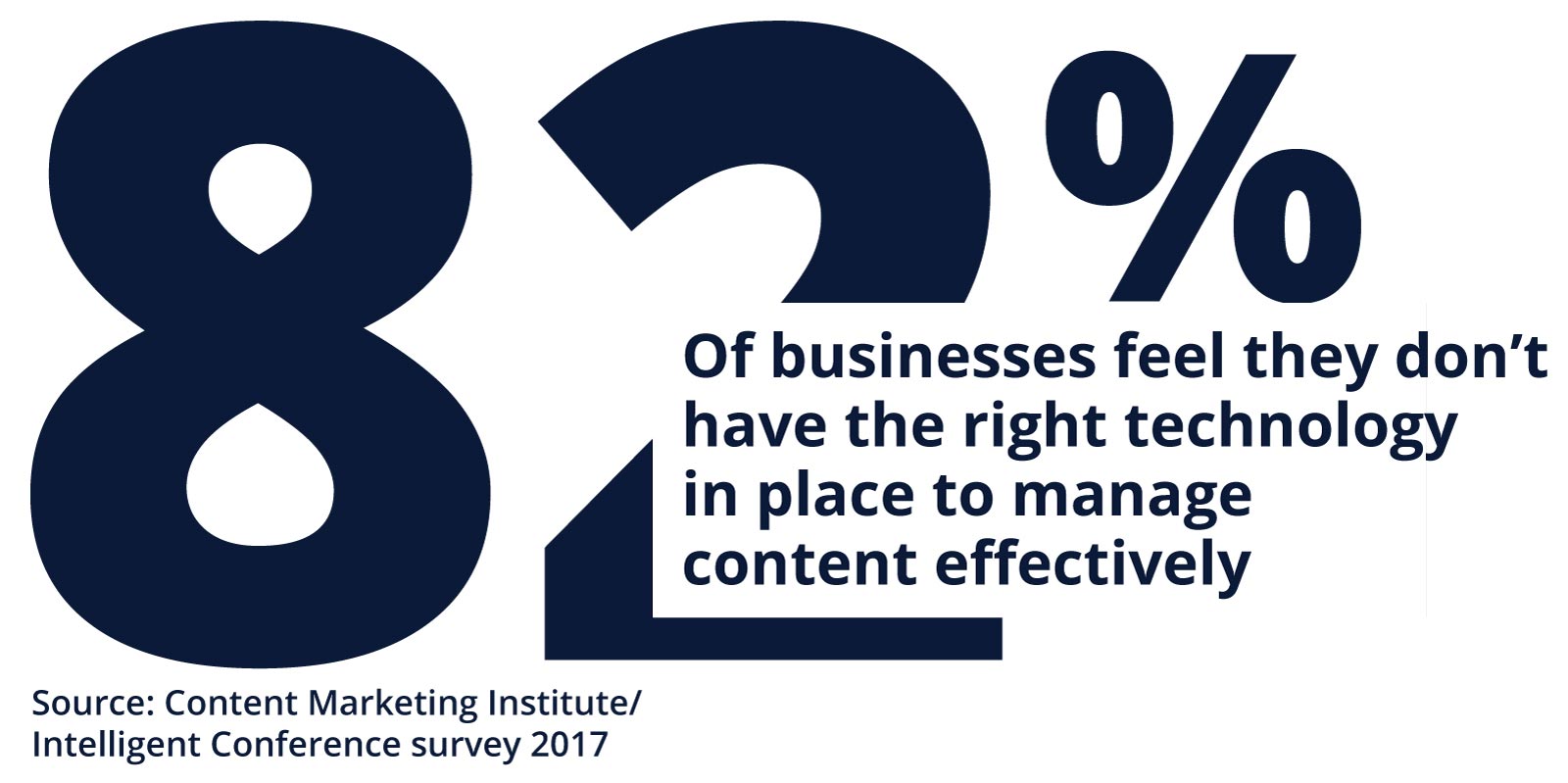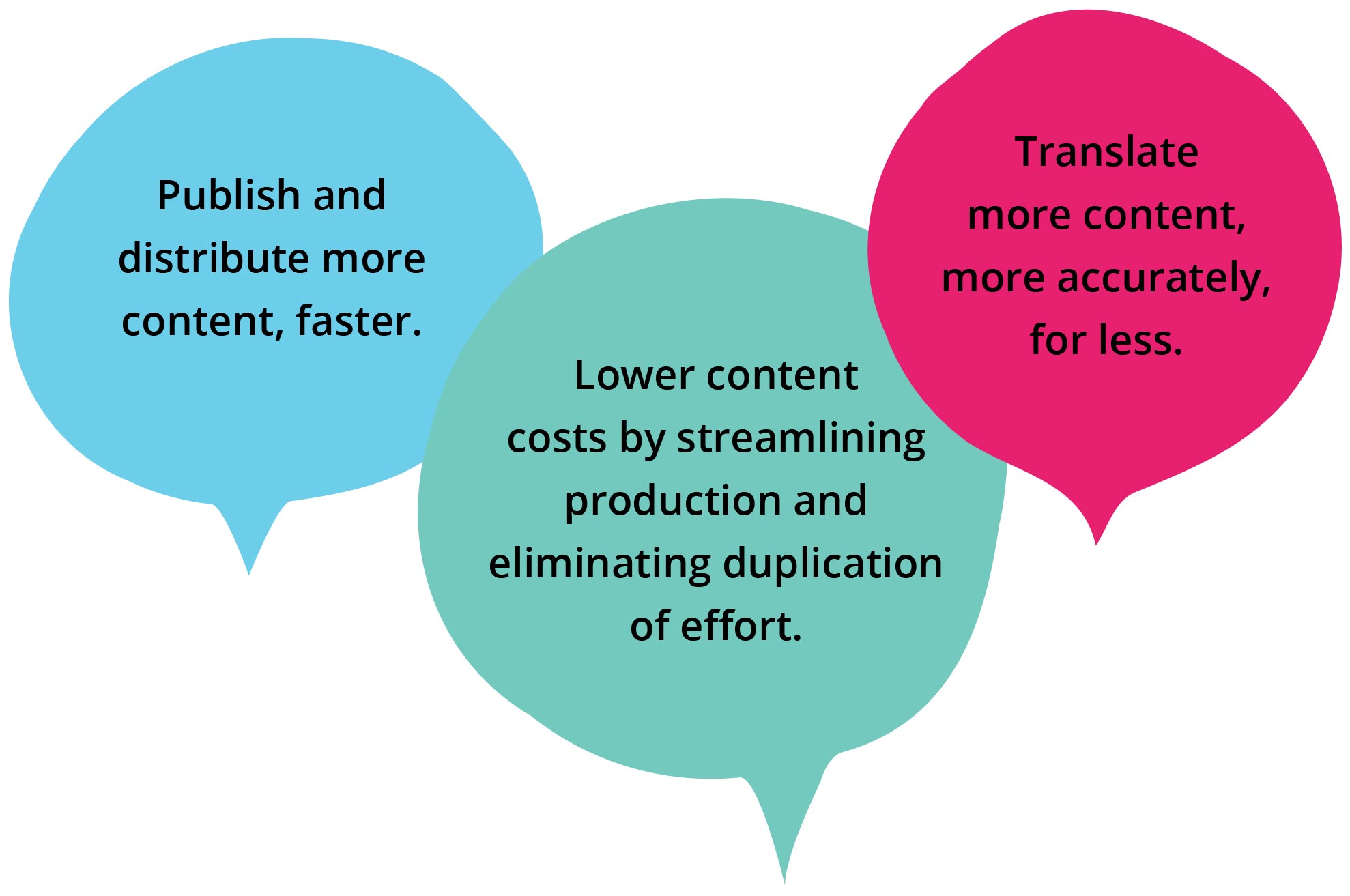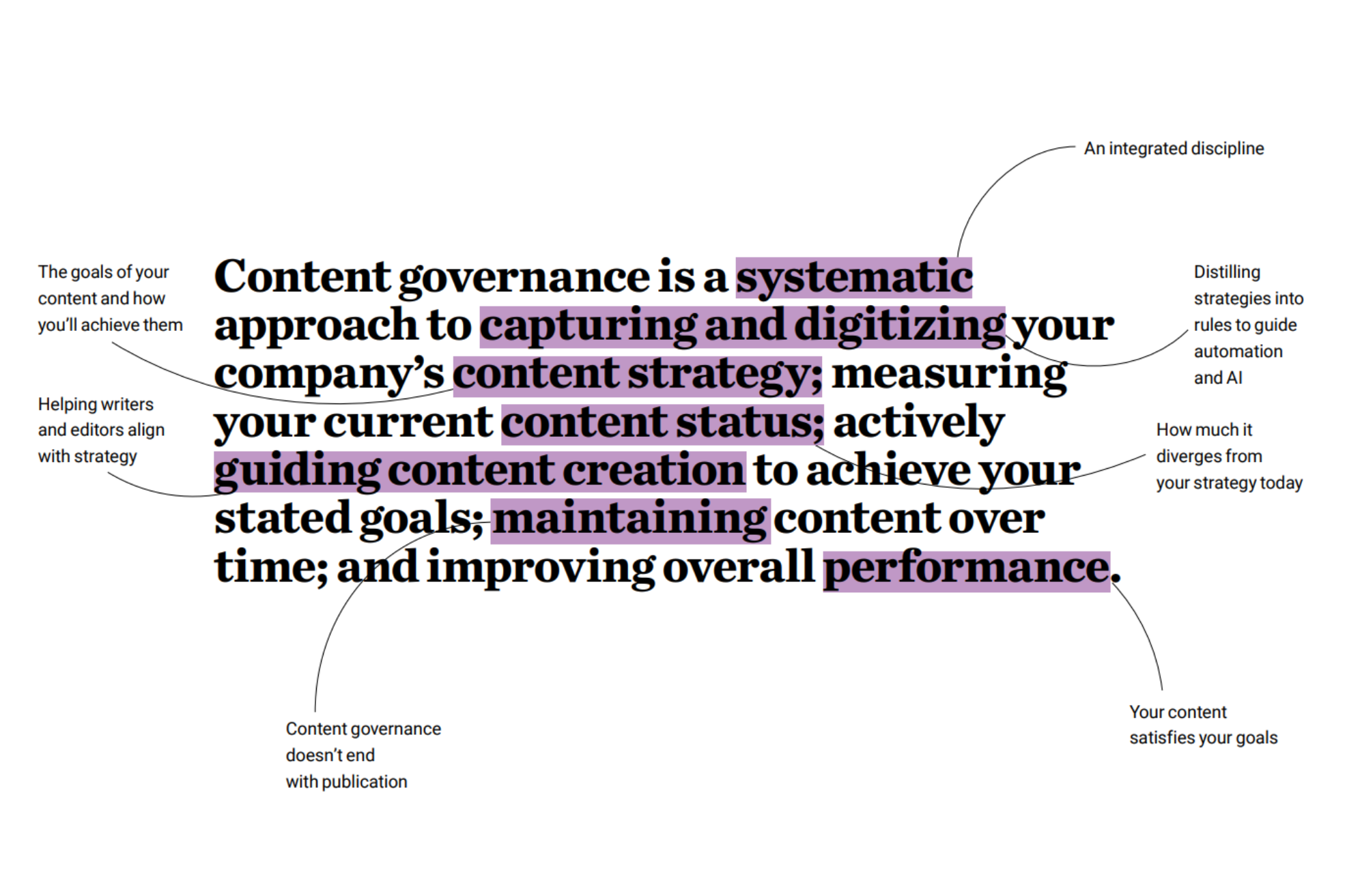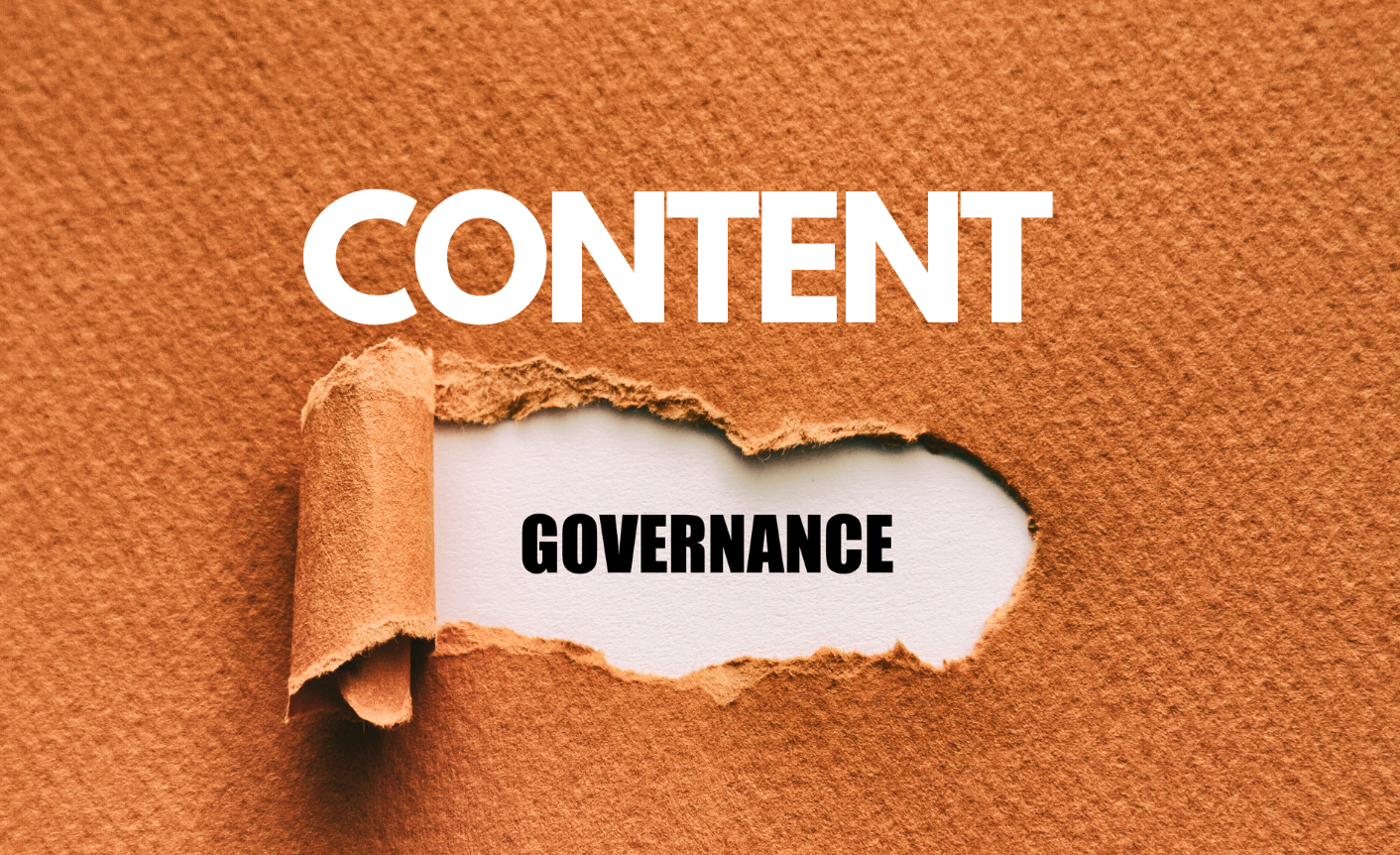Content governance is about operationalizing your content strategy at scale. It’s a way to bring order to the chaos that probably exists in your company’s content operations, and to help everyone who creates and relies on that content to deliver better business outcomes. Below we’ve compiled our best resources on Content governance but for a deeper dive, check out “The Enterprise Content Governance Playbook”.
In recent years, customer-facing content has exploded in volume and fragmented in every possible way. Today, far more people are producing far more customer-facing content than ever before. Most companies know that a strategic content governance framework is key to creating and delivering content that delivers measurable business results. It does that by creating an incredible customer experience.
It’s almost too obvious to say out loud, but customer experience is the most important determinant of success or failure in every market. What’s less obvious is the value of content in customer experience.
Customer experience isn’t just confined to product experience, and content touches every part of the customer journey. Yes, really! Emails, website copy, blogs, brochures, product information, technical documentation, eBooks, support and knowledge base articles, social media posts — the list is endless.
Of course content has always been an important part of customer journeys. But as the world goes digital, two things have happened. For brands, content has become dramatically easier to produce, publish, and promote. Meanwhile, for buyers, it’s become much easier to discover, consume, and share.
So what happens when you’ve got unlimited supply and insatiable demand?
You wind up with a content explosion, both in terms of volume and variety. Today, every major company is trying to create content that’s a competitive differentiator, in an environment where:
- More departments and disciplines are becoming publishers, creating and distributing content to advance their goals.
- More people are creating, editing, and publishing, with hundreds or even thousands of authors serving a typical global brand. And while many of them are experts, very few are professional writers.
- There are more channels to publish in. Content is spreading beyond the company walls, across the web, in social media, in GitHub repositories, and inside your own domains, in knowledge bases, customer service databases, self-service support sites, tech documentation centers, and marketing hubs.
- Everything is going global, and therefore needs to be translated, by humans and machines, to reach more markets.
Each of these dimensions multiplies the issues created by the others. This leads to fragmentation, duplication, quality and consistency issues, content silos, cowboy content operations, and buyer confusion.
The result is content chaos, and it’s costing your company a fortune!
That’s because human editors and manual control processes can’t come close to solving this problem. So businesses pay the price. Actually, they pay many prices, including:
All of this adds up to a huge waste of time and money. But the biggest cost is confusing, fragmented, inconsistent customer experiences. With so many different people working on content across so many disconnected silos, content ends up being off-strategy, off-brand, undiscoverable, poorly written, and quickly out of date.
Of course, most companies are trying to get a handle on this problem. But they’re hamstrung by one big issue — Traditional attempts to govern content just aren’t fit for purpose.
“Content governance is owning your content. Having the ability to edit, update, archive, publish, unpublish, and eventually change it for the times, all within a really structured set of guardrails.”
– Megan Nixon, Senior Content Strategist
Why what you’re already doing doesn’t cut it
There are ways of governing content that have been around for a long time. And while they still have their place, the problem is they weren’t designed for today’s enormous content requirements. Plus, in a world of content chaos, where more people are creating content and publishing it across loads of channels, they simply aren’t up to the challenge.

Consider the following traditional approaches to governing content and why they just don’t work:
- Brand guidelines and style guides
Most businesses have their own brand bibles and style guides that they make available to everyone creating content. While valuable resources in theory, in practice, they’re woefully underused. The problem is that they’re impractical. They tend to be long PDF documents that are too easy to forget and difficult to browse. Style guides for writers suffer the same limitations. Even the most modern, online company style guide, with a glossary of thousands of preferred terms, are just too unwieldy to be of use in the act of writing. As a result, most writers ignore them. - Training
Putting writers and editors through courses, live or online, to coach them on best practices is a good idea. However, good habits slip over time. So unless you’re sending your writers to regular refresher courses, which are expensive, training has a limited, fast-decaying impact. - Manual editing
Having an actual human being edit every piece of work your writers produce may be ideal, but it’s impossible to scale. At best, your editors will touch a small fraction of your total content universe. Recruiting a large team of editors can also lead to consistency problems. Since editors each have their own style, it’s difficult to reach consensus on the best approach. As a result, each of your assets reads differently. - Approval workflows and policies
Establishing the right content production workflows makes sense, but you also need to document and enforce them. All too often this isn’t done, so, like brand guidelines, they end up ignored or forgotten. And, even when they’re embedded into processes, they still depend on human reviewers and approvers (and you’re back to the cost and scale problem)
The writing’s on the wall. The early attempts to govern content worked in the old, low-volume days, but they have no chance in the new digital world. They have a limited impact they’re hard to enforce, and impossible to scale. They also fail to address the most important governance goals. For example, they don’t validate content against content strategy and they don’t track performance over time. And this is where enterprise content governance comes into play.
The solution? Enterprise content governance
Enterprise content governance has emerged as a discipline in response to the skyrocketing amounts of (and demands on) customer-facing content, and the inherent limitations of traditional governance approaches. It’s a systematic approach to capturing and digitizing your company’s content strategy; measuring your current content status; actively guiding content creation to achieve your stated goals; and improving overall performance over time.
In other words, enterprise content governance operationalizes content strategy. It takes its key elements — your goals, priorities, and policies — and turns them into actionable processes and metrics.
Admittedly, the word governance has a bad reputation. Some of the most ardent advocates of content governance still shy away from using it among lay people. But, in the end, these pioneers understand that governance really is the right word for this hugely important discipline.
They also understand that the word’s less welcome connotations (rules, authority, constraints) are outdated. Today, governance is seen as a value-creating role in a wide range of business contexts, most recently in the booming field of data governance. The trend is clear: governance is what happens when a culture grows up and learns to take care of the things it values.
Leaders in enterprise content governance have shown that a collaborative “center of excellence” mindset is far more effective than a draconian “command and control” one. The best content governance frameworks create coaches not cops.
When people talk about content governance, they’re really talking about content strategy — understanding what content is for, then taking active steps to ensure it meets its goals.
– Volker Smid, Acrolinx CEO
The benefits of enterprise content governance
Enterprise content governance is about operationalizing your content strategy. A great way to do that is by using a content impact platform that’s powered by Artificial Intelligence. That way, you can apply rules, manage content assets, enable writers, and measure performance — all with very little human intervention. For larger companies, it’s a much easier way to scale up an enterprise content governance program.
With the right platform, you can actively manage the quality, clarity, consistency, strategic compliance, and impact of the content that drives your customer experiences. As a result, the overall value of your content improves.
Practically speaking, that means that enterprise content governance doesn’t just pay one dividend. Rather, it delivers many benefits across the customer journey and the entire business. The internal process benefits alone are significant. They help you:

But there are even bigger customer experience wins that allow you to:
- Deliver on your content strategy by only publishing content that’s consistent, on-brand, and on-strategy.
- Amplify the impact of your content by making sure every piece helps your prospects and customers succeed.
- Extend the reach of your content by making it more discoverable and accessible.
- Deliver better, content-driven customer journeys by creating consistent, high-quality experiences that will attract, retain, and satisfy customers.
These are huge gains that contribute to every metric that matters in sales, marketing, product marketing and management, and customer service. And they pay dividends again and again across your business.
Why the time for enterprise content governance is now
Over the last few years, there’s been an explosion of interest in enterprise content governance. Here’s why:
- Companies value their content more. They recognize that it’s a major factor in customer experience and a real source of competitive advantage.
- The scale of the problem has triggered action. The explosion of content volumes and varieties is creating undeniable issues across all customer-facing departments.
- Data-driven approaches are winning. Establishing KPIs and applying analytics has become a best practice in almost every aspect of business. Content is no exception.
- The technology is ready. Important innovations — including AI, automation, software platforms, microservices, and API models — have converged to make scalable, automated governance and guidance possible.
This cluster of trends has paved the way for a sharp rise in content governance. It’s also led to a growing community of professionals coming together to solve their common challenges.
The four-step enterprise content governance framework
Every organization’s content governance journey is different, but they all tend to cover these four essential steps, more or less in order:
- STEP 1: Capture and digitize your content strategy.
It’s hard to operationalize a content strategy that’s locked in a slide deck or PDF and stuck on a server somewhere. The first step in content governance is to create a documented strategy that is clear, defined, aligned, and deployable. And that means establishing a set of goals, policies, processes, and metrics — and making it instantly available wherever content is created, edited, reviewed, and tracked. You can use a content impact platform to help you do this work. It does this by capturing your content strategy and then building APIs to it, so other software, processes, and systems can access it as needed. Digitizing your strategy and policies lets you put them right where writers work and where content lives. - STEP 2: Establish where you are today.
You’ve translated your strategy into things you can deploy and measure. Now it’s time to see how you’re doing. At this stage, you compare your strategy to reality, using the metrics and targets you established in Step 1, and identify the gaps. Your findings may be something like “Only 6 percent of our content gets reviewed before publishing, compared to our goal of 75 percent.” or “Our tone of voice scores for our support topics are far too low.”Once you’ve captured performance against your agreed metrics and targets, the major gaps leap out at you, and it becomes easy to prioritize your governance (and remedial) efforts. - STEP 3: Deploy your governance and guidance framework.
Governance can’t just be about measuring and tracking your content’s effectiveness. It also needs to let you step in and improve that effectiveness. That’s where the guidance function comes in by actively helping your content writers and editors raise their game.So how should you deploy your enterprise content governance and guidance framework to help content creators across your organization?:- At the point of creation – guiding writers as they write, alerting them when they’re using an outdated product name, or missing a ™, or an opportunity to use an SEO key phrase, or straying from your target tone of voice.
- In their content creation tool of choice – whether that’s Word, Google Docs, WordPress, or any other tool they use. A guidance sidebar can help them review their work, spotting errors and diversions from strategy, and apply Natural Language Processing, AI, and writing guidelines to improve their content effectiveness as they work.
- Using transparent metrics – the guidance sidebar shows the writer a numerical score, reflecting how close they are to delivering content that’s on-strategy, on-brand, and on-voice. They can see why they got that score and exactly how to improve it before pressing “submit” or “publish.”
- STEP 4: Measure, report, and improve.
The metrics used on the guidance side of the house also inform the governance side. All content consistency and performance KPIs are pumped into a governance analytics dashboard where they can be monitored, queried, and tracked over time. Your global content governance dashboard then lets you see your overall performance against your chosen metrics and goals (by department, content type, author, editor, department, etc.). And the governance tools can also be pointed at any content repository (from a DAM system to GitHub) for a scheduled or batch analysis.
Content governance is about long-term stewardship of the customer experience.
– Tom Williams, Director – Knowledge Platforms, Autodesk
A final note on enterprise content governance
The debate is over. The business world has recognized that the most successful companies in every market are those that deliver the best customer experiences. These top performers have all discovered the critical role that content plays in their customer journeys. And they’re all getting serious about treating their customer-facing content as the strategic business asset that it is.
How do successful businesses treat strategic assets? They govern them. Actively, not passively. Using not just strategies and policies but data and metrics as well. That’s what enterprise content governance is all about: operationalizing and tracking your content strategies to drive improvements in content performance. Well-governed content adds value through the entire customer lifecycle, from first touch to ongoing relationships and loyalty.
If this post has shown you one thing, we hope it’s that enterprise content governance is a powerful, strategic discipline driven by measurable commercial benefits. To tap into even more help to guide you on your content governance journey, see the resources below.
Want Even More Information? Download our Enterprise Content Governance Playbook.




